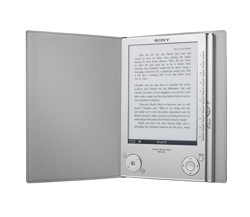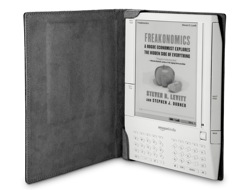Amazon's Kindle: Wireless e-Paper for the Non-Geek
 Last week, Amazon.com announced its newest big venture, the Amazon Kindle. It seems to be the second major entry into the world of eBooks that are functional and will help develop this potential new market.
Last week, Amazon.com announced its newest big venture, the Amazon Kindle. It seems to be the second major entry into the world of eBooks that are functional and will help develop this potential new market.
First of all, these eBook Readers use a technology called e-Paper, which seems to be something like a computerized Etch-A-Sketch. The machine has black and white pixels, and the reader only uses power to change whether the pixels are on or off. Thus, while reading a page, it takes no battery power; the Reader only needs power to change the content of a page. The only major side-effect seems to be that some readers get annoyed by the process of redrawing (or "turning") the page.
 Sony recently launched their second version of the Reader platform, which I had the chance to play with at the local Target store a couple days ago. The product is very small and silver. You add books to the Reader via synchronizing with your computer. The best formatted books are all purchased through the Sony Connect store, but you can upload any PDF and it will work fairly well. Navigation seems to be simple and sleek, with less than a dozen buttons on the device. Priced at $250, it's definitely still for early adopters and bookish peoples, but not a ridiculous amount.
Sony recently launched their second version of the Reader platform, which I had the chance to play with at the local Target store a couple days ago. The product is very small and silver. You add books to the Reader via synchronizing with your computer. The best formatted books are all purchased through the Sony Connect store, but you can upload any PDF and it will work fairly well. Navigation seems to be simple and sleek, with less than a dozen buttons on the device. Priced at $250, it's definitely still for early adopters and bookish peoples, but not a ridiculous amount.
In comparison, the Amazon Kindle has many interesting new features, mostly relating to getting items on your Kindle. The Kindle includes a wireless EVDO modem, which gives you access through an unnamed cell phone provider (for free). This allows Amazon to market to those who don't use the internet much or at all, because they don't need a computer to use the Kindle at all. Plus, with the wireless distribution, the Kindle has a number of other features, such as newspaper and magazine subscriptions to be delivered automatically to your Kindle. (Also, for those snooty bloggers who want people to pay for their content, you can subscribe to enhanced RSS feeds of Slashdot and people like Robert Scoble.)
 With these enhancements come some downsides, I think. First, for user-interface reasons, because you do not have a computer to sync with, the Kindle needs to have a keyboard. And much of the front real estate is taken up with a small keyboard for hunting and pecking. Second, the rechargeable battery get quickly eaten up with features such as the Wireless and mp3 playing functionalities, although both can, of course, be turned off. The user interface seems like it may be a bit clunkier than the Sony Reader, mostly because the selection buttons have been replaced with a small scroller wheel or something.
With these enhancements come some downsides, I think. First, for user-interface reasons, because you do not have a computer to sync with, the Kindle needs to have a keyboard. And much of the front real estate is taken up with a small keyboard for hunting and pecking. Second, the rechargeable battery get quickly eaten up with features such as the Wireless and mp3 playing functionalities, although both can, of course, be turned off. The user interface seems like it may be a bit clunkier than the Sony Reader, mostly because the selection buttons have been replaced with a small scroller wheel or something.
Most importantly, the Amazon Kindle is selling for a whopping $400. This isn't an Apple product, and with the beige-white look to it and the many, small buttons, it's not winning any great design awards either. I don't expect the Kindle to catch on unless they drop the price in half to increase the adoption of this new device. Still, for people who love to read and want to cut down on paper and bulk in their backpack, this may be the perfect solution.
Comments
Thanks for the info, and thanks for not taking a heavy pro and anti stance. It seems so many people are for or against without even seeing the thing first hand.
Add new comment